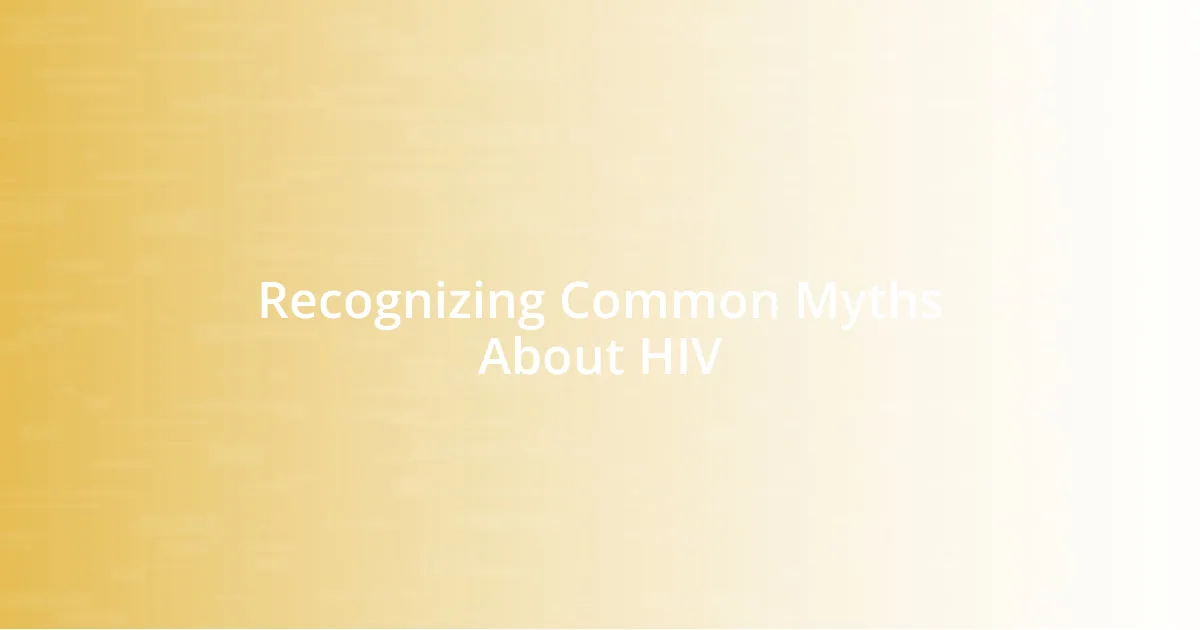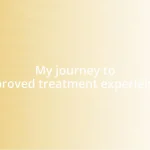Key takeaways:
- Understanding HIV requires awareness of its medical implications and social stigma, emphasizing compassion and education.
- Addressing and debunking common myths is essential for fostering inclusive education about HIV risks and treatment.
- Engaging with healthcare professionals and attending awareness workshops can transform perspectives and empower advocacy for HIV awareness.
- Connecting with supportive communities, both online and in-person, provides encouragement, shared experiences, and a sense of belonging in addressing HIV-related challenges.

Understanding HIV and Its Risks
HIV, or Human Immunodeficiency Virus, fundamentally alters the way we think about health and relationships. When I first encountered the topic, I remember feeling a rush of confusion mixed with fear. How could one virus change so many lives? The reality is that understanding HIV requires acknowledging both its medical implications and its social stigma.
One crucial aspect of HIV is how it can be transmitted. Initially, I wouldn’t have guessed that sharing needles or unprotected sex are significant risks. I learned that even breastfeeding could pose a risk if the mother is HIV-positive. This revelation struck me deeply; it reminded me of the importance of compassion and education in combating misunderstanding about the virus.
The emotional weight of HIV cannot be overstated, particularly in how it affects relationships. I once had a friend whose partner tested positive. Watching their struggle made me realize how fear and misinformation can lead to isolation. It’s a stark reminder that, while the virus is a medical issue, the emotional and psychological impacts are just as significant. How can we bridge that gap between knowledge and empathy? That’s a question that continues to resonate with me.

Recognizing Common Myths About HIV
It’s surprising how many myths surround HIV, and some of these misconceptions can seriously impact people’s lives. For instance, many people believe that you can get HIV from casual contact like hugging or sharing utensils. I once thought the same until I dug deeper and learned that HIV is only transmitted through specific body fluids, such as blood, semen, vaginal fluids, and breast milk. This realization helped me appreciate the importance of breaking down barriers of ignorance.
Another myth I encountered was the idea that only certain groups of people are at risk. I remember discussing this with friends, and it struck me how prevalent this belief is. The truth is, anyone can contract HIV, regardless of their age, race, or sexual orientation. This knowledge made me reflect on the necessity of inclusive education—everyone deserves to understand their risks without judgment or stigma.
Lastly, there’s the pervasive belief that a positive HIV status means an immediate death sentence. I still recall a story I read about a young man thriving despite being HIV-positive, managing his condition with the right treatment and lifestyle. It showed me that with proper medical care, individuals can lead long, fulfilling lives. This insight is crucial for dismantling fears and fostering understanding and support for those affected by the virus.
| Myth | Fact |
|---|---|
| You can get HIV from casual contact | HIV is transmitted through specific body fluids only. |
| Only certain groups of people are at risk | Anyone can contract HIV, regardless of demographics. |
| A positive status is a death sentence | With proper treatment, individuals can live long, healthy lives. |

Researching Reliable HIV Resources
Researching reliable resources on HIV was a journey that opened my eyes to both knowledge and the complexities surrounding the virus. I remember my initial frustration when trying to sift through the overwhelming amount of information available online. I decided to focus on sources that were not just informative but also credible—such as websites from health organizations, reputable medical journals, and community health agencies that specialize in HIV support and education. My quest wasn’t just about gathering facts; it was about building a foundation of trust and understanding.
Here are some trustworthy sources I found invaluable:
- Centers for Disease Control and Prevention (CDC): The CDC provides comprehensive information on prevention, testing, and treatment options.
- World Health Organization (WHO): WHO offers global insights on HIV trends and research, emphasizing the importance of public health initiatives.
- National Institutes of Health (NIH): NIH focuses on research advancements and clinical trials that can lead to improved treatments and outcomes.
- local support groups: Connecting with local organizations allowed me to hear personal stories, providing context that statistics alone couldn’t offer.
Finding the right resources wasn’t just about facts; it was about creating a deeper connection to the subject. When I came across personal testimonies from those living with HIV, it transformed my understanding. Suddenly, the data didn’t just represent numbers—it represented lives, struggles, and triumphs. One story that stuck with me was of a woman who bravely shared her journey, emphasizing how access to accurate information allowed her to redefine her identity beyond the virus. That’s what striking the right balance between science and personal experience is all about.

Engaging with Healthcare Professionals
Engaging with healthcare professionals can be a game-changer in understanding HIV risks. I remember my first appointment with my doctor, feeling a mix of apprehension and eagerness. As we talked, I realized that asking questions wasn’t just encouraged—it was essential. I found that when I expressed my concerns openly, it not only clarified my doubts but also formed a trusting relationship that made discussing sensitive topics much easier.
During one consultation, I mentioned a few myths I had heard from friends about transmission risks. The doctor appreciated my initiative and took the time to debunk those misconceptions thoroughly. It dawned on me that healthcare professionals are often eager to share their knowledge. Have you ever thought about how much a simple conversation can change your perspective? For me, that exchange illuminated the critical role they play in shaping our understanding of health.
As I continued to engage with various specialists, I became more comfortable discussing not just HIV but other health matters too. I remember a session with a nurse who was passionate about preventive care. Her enthusiasm was contagious! It inspired me to take responsibility for my health while emphasizing the importance of ongoing dialogue with my healthcare providers. This was not just about seeking information; it was about building a partnership in my health journey.

Attending HIV Awareness Workshops
Attending HIV awareness workshops was one of the most eye-opening experiences on my journey to understanding the virus. The atmosphere was welcoming, encouraging open dialogue, and I vividly recall the palpable sense of community among attendees. It was not just about lectures; it was about shared stories and collective learning. Have you ever found yourself in a room full of people where everyone is there for the same reason? That sense of solidarity made the experience profoundly impactful.
One particular workshop I attended featured a panel of speakers, including healthcare professionals and individuals living with HIV who shared their personal journeys. Listening to their experiences brought a layer of humanity to what I previously only understood through statistics. I remember a young woman describing how she transformed her fear into advocacy work, emphasizing the importance of awareness and education. Her passion stirred something within me, prompting me to ask myself: How can I use my voice to contribute to this conversation? It made me realize that education is not just for personal growth, but it can also empower others.
After participating in these workshops, I discovered how vital it is to cultivate a network of informed allies. I still recall the connections I made with fellow attendees who shared similar questions and concerns. Together, we navigated through misconceptions and learned about the latest prevention methods and treatments. That supportive environment gave me the courage to continue seeking knowledge and to advocate for HIV awareness in my community. Wouldn’t it be amazing if more people engaged in these conversations? For me, attending these workshops not only educated me but also motivated me to become an advocate for change.

Connecting with Supportive Communities
Building connections with supportive communities was a pivotal step in my self-education about HIV risks. I remember joining an online forum dedicated to discussing HIV, where I found a safe space to ask questions and share experiences without fear of judgment. The camaraderie among members was extraordinary; it felt like discovering a family who understood and embraced the reality of living with or being affected by HIV. Have you ever stumbled upon a group where you can be your true self? I sure have, and it was liberating.
What struck me most was the diversity of stories shared in those digital discussions. Each person brought their unique perspective, enriching my understanding of the virus’s impact on various lives. One day, a member shared their journey of navigating the stigma surrounding HIV, and I felt a deep sense of empathy for their struggles. It made me wonder: how many more people are out there silently dealing with the same issues? That thought motivated me to participate more actively and become a source of support for others, highlighting the beautiful reciprocity of knowledge and encouragement in these communities.
In-person support groups also became a lifeline for me. I remember attending my first meeting, feeling slightly nervous but also hopeful. The stories shared by others created a powerful sense of belonging that made a difficult topic easier to discuss. In that circle, I saw firsthand how vulnerability could spark connection and healing. Have you ever felt the weight of isolation lift simply by sharing your experience with others? For me, these gatherings illuminated the truth that we’re all in this together, helping each other to grow, learn, and heal through shared struggles and triumphs.















